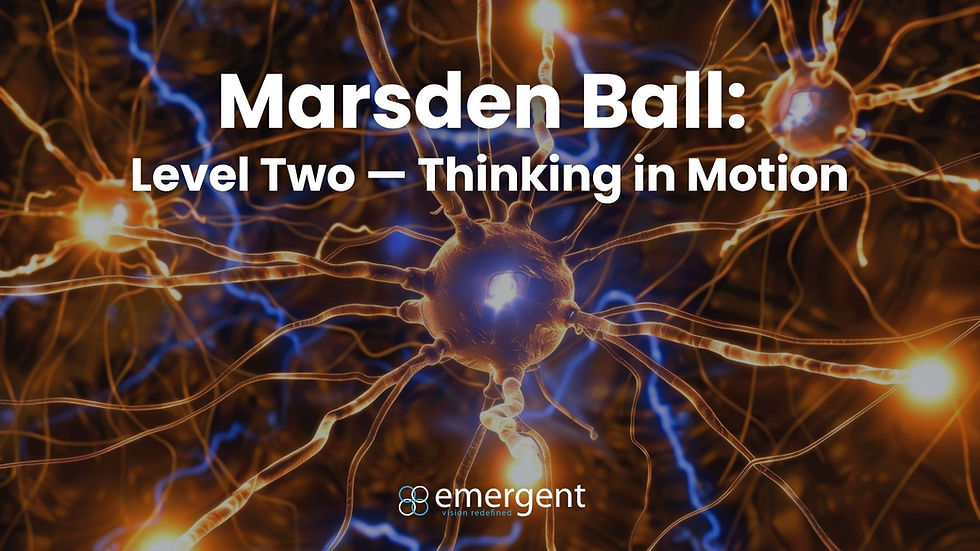Children's Vision and Learning Month: It's Not About Tutoring, It's the Foundation
- Robert Nurisio, COVT

- Aug 22
- 3 min read
Updated: Aug 25

When parents hear “vision therapy,” many might assume it’s a tutoring program for reading.
Spoiler alert: it’s not.
Vision therapy doesn’t teach your child how to decode words or comprehend a passage; instead, it develops the visual efficiency and processing skills that make reading possible in the first place. Think of it like upgrading the operating system before running a big program. Without the upgrade, even the best software crashes.
Reading is a neurologically complex task that requires precise coordination of multiple visual skills. Imagine trying to read while your eyes can’t maintain alignment (binocular instability) or while the print seems to drift across the page due to poor fixation control. Even the most well-designed phonics program can’t overcome those obstacles. Vision therapy works on the underlying visual abilities, such as saccadic eye movements, accommodative facility, central–peripheral integration, and vergence control. These skills together form the foundation of fluent, comfortable reading.
Another common misconception we run into: if a child struggles to read, they just need more practice. Experience tells us this is not reality. If the visual system is inefficient, repetition only increases frustration. It’s like asking someone with a sprained ankle to keep running laps. Without addressing the underlying mechanics, practice alone often leads to avoidance, fatigue, or reduced comprehension. At the end of all it, we are no better than we were when the challenges began.
Take saccades, for instance. These are the rapid, ballistic eye movements that allow us to shift fixation from one word (or group of words) to the next. Efficient saccades are essential for line-to-line progression in reading. When they’re poorly calibrated, a child may skip words, re-read the same line, or lose their place entirely. This isn’t a motivation issue, and it’s definitely not a comprehension problem. It’s a motor control problem, plain and simple. Vision therapy trains saccadic accuracy, amplitude, and rhythm so the eyes can land exactly where they need to, every time.
Equally important is accommodative flexibility, which is the ability to quickly and accurately adjust focus between different viewing distances. Classroom demands constantly require shifts from near to far all day every day. A child with accommodative infacility may experience blur, eye strain, or headaches, all of which compromise reading fluency. Vision therapy provides systematic, graded activities to strengthen both the speed and sustainability of accommodation.
Now consider central–peripheral integration. The central visual system provides detail, the ability to decode individual letters and words, while the peripheral system maintains spatial awareness and flow, allowing the reader to track across a line and smoothly transition to the next. If these two systems are poorly integrated, a child may feel visually “crowded,” lose their place, struggle with rhythm and pacing, or even show challenges in mathematics or sports performance.Vision therapy trains the eyes and brain to balance central precision with peripheral guidance, enabling reading that is both accurate and efficient.

I would like to pause for a moment to repeat that vision therapy is not a substitute for reading instruction. We don’t teach phonics, vocabulary, or comprehension strategies. Instead, we remove the physiological barriers that make those skills so difficult to apply. It’s the difference between tuning a piano and teaching someone to play music; one prepares the instrument, the other creates the melody. Both are necessary, but in the right order.
The outcome? Once these visual skills are strengthened, reading often accelerates naturally. Parents regularly report that their child “suddenly enjoys reading” or “doesn’t avoid homework anymore.” Not because we taught reading, but because we eliminated the invisible roadblocks. Vision therapy clears the neural pathways so the child can finally access their full potential as a reader.
And the best part? Once the eyes and brain start working together, reading stops feeling like an Olympic Event and starts feeling more like, well, a story. Suddenly, kids aren’t just surviving their homework, they’re devouring entire chapters before you can say, “Lights out!”
So, while vision therapy won’t turn your child into the next Shakespeare overnight, it just might stop them from treating the bookshelf like it’s full of booby traps. Because at the end of the day, reading should open doors, not create headaches.





Comments